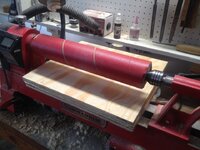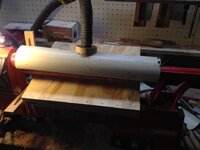Marmotjr
Member
Got mine fully running today. It's been a 6 month deal, making a bit here or there. It's been running for about a month or so, but I only sanded a few segmented rings with it. Today I planed down some 3/4 stock to remove a severe cup and bow. I won't do that again. That's why I'm ordering a planer in the next few weeks. In the first picture you can see my wimpy DC. That was trying to suck up all the dust. I ended up opening the windows and garage door for a cross breeze and ended up putting on my full face respirator. I usually only wear a half face for dust. When I was done with the first side of the boards, I looked like this:

That wasn't gonna fly. My whole shop is covered. Had some 4" thin PVC laying around, and after a bit of MacGyvering, I had the DC rigged to a shield over the drum. Not only is the DC near perfect now, but there's also a shield to protect me from bumping the drum, which is a real possibility with this rig.
During the second run to flatten the other side of these boards, Even with the DC off, the amount of dust getting kicked into the air is severely reduced. With the DC, I didn't even notice any dust. The pile on the bed is from the entire run, taking about 1/16" off of 3 12"x18" boards. I had that much in my hair alone after the first run. Bonus too, the offcut of the PVC pipe can be similarly rigged, but mounted behind the lathe for normal DC. yay.
So... spec if anybody wants:
Base is 3/4" ply, 2 1/4" bolts attach to Tnut blocks under the ways to secure the bed. 3/8" T nut in the back of the base. allows for a 10" Bolt to raise or lower the feed bed. Bed is attached with a piano hinge, is sanded to 320 and a thin coat of paste wax.
Drum is a 4x4 post that I turned down, sanded as straight as I could. Hardwood glue block (and screwed) is tapped to 1"x8, and is attached to the end of the drum. Hole for live center on other end. 4"x48" (?, might be 40") 60 grit Belt sanding belt is attached to the drum with spray adhesive. Next generation of the drum will have velcro on the drum and replacable belts will be used.
Boards are passed through the sander, starting away from you and pulling it under very gently. If the piece launches, it will go away from you, but is now basically a lumber cannon. There is a huge danger of getting your hand sucked in if you get too close. I doubt my lathe would cause a loss of limb or smaller appendages, but it'd still hurt and remove a bunch of skin. A bigger lathe may be able to pull arms in. Safety first!.
The final boards only show about +/-.002 difference after one pass, which can be evened out with another pass, rotating the board. If you don't maintain perfect feed speed though, some pretty nasty snipe does occur. Especially with these boards which were too long to start feeding in the correct orientation, so I had to pivot them into the sander. Those corners are a bit more worn.
If anybody wants specs/pics for the DC shield, I'll be more than happy.

That wasn't gonna fly. My whole shop is covered. Had some 4" thin PVC laying around, and after a bit of MacGyvering, I had the DC rigged to a shield over the drum. Not only is the DC near perfect now, but there's also a shield to protect me from bumping the drum, which is a real possibility with this rig.
During the second run to flatten the other side of these boards, Even with the DC off, the amount of dust getting kicked into the air is severely reduced. With the DC, I didn't even notice any dust. The pile on the bed is from the entire run, taking about 1/16" off of 3 12"x18" boards. I had that much in my hair alone after the first run. Bonus too, the offcut of the PVC pipe can be similarly rigged, but mounted behind the lathe for normal DC. yay.
So... spec if anybody wants:
Base is 3/4" ply, 2 1/4" bolts attach to Tnut blocks under the ways to secure the bed. 3/8" T nut in the back of the base. allows for a 10" Bolt to raise or lower the feed bed. Bed is attached with a piano hinge, is sanded to 320 and a thin coat of paste wax.
Drum is a 4x4 post that I turned down, sanded as straight as I could. Hardwood glue block (and screwed) is tapped to 1"x8, and is attached to the end of the drum. Hole for live center on other end. 4"x48" (?, might be 40") 60 grit Belt sanding belt is attached to the drum with spray adhesive. Next generation of the drum will have velcro on the drum and replacable belts will be used.
Boards are passed through the sander, starting away from you and pulling it under very gently. If the piece launches, it will go away from you, but is now basically a lumber cannon. There is a huge danger of getting your hand sucked in if you get too close. I doubt my lathe would cause a loss of limb or smaller appendages, but it'd still hurt and remove a bunch of skin. A bigger lathe may be able to pull arms in. Safety first!.
The final boards only show about +/-.002 difference after one pass, which can be evened out with another pass, rotating the board. If you don't maintain perfect feed speed though, some pretty nasty snipe does occur. Especially with these boards which were too long to start feeding in the correct orientation, so I had to pivot them into the sander. Those corners are a bit more worn.
If anybody wants specs/pics for the DC shield, I'll be more than happy.



![IMG_4345[1].jpg](/data/attachments/138/138521-06a2b12c2b4b5934a0749888112c6675.jpg?hash=BqKxLCtLWT)
